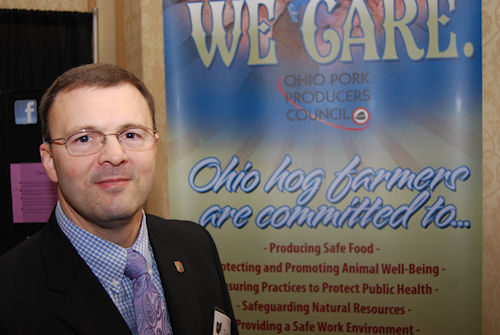
It’s exciting times for Ohio pork producers, according to Todd Stickley, president of the Ohio Pork Producers Council. We had a chance to sit with Todd at the Ohio Pork Congress last week and he said the mood of the pork industry is very positive. Stickley is also director of pork finishing and development for Kalmbach Swine Management, LLC.
Ohio Farmer: You say pork producers are in a pretty good mood. Why?

YOU TUBE PROOF: Todd Stickley urges producers to make sure what goes on in their barn would be considered acceptable to consumers if it were filmed and appeared on social media.
Stickley: There are many reasons to be optimistic about our pork industry. As an example, sow productivity is significantly better than it has ever been before. While we were happy to get 20 pigs per litter a decade ago, today’s goals are typically set at 30 pigs per sow per year (P/S/Y). So even though the sow numbers in Ohio have not changed dramatically, because of increased sow productivity, the amount of pork being produced in our state has been up significantly.
OF: Does that spill over into other areas?
Stickley: You bet. For example, if you have 22,000 sows and you add just 1 P/S/Y, you are going to need 11,000 more finishing spaces. And that is good for the pork industry as a whole, from construction companies, to feed manufactures to harvesting plants.
OF: Where are these finished hogs going?
Stickley: More of them are moving into the export markets. We are now selling one in four of our hogs outside the country. Japan and Mexico are very strong markets for us. The free trade agreement with South Korea offers another good marketing opportunity.
OF: Does that mean more opportunities for farmers as well?
Stickley: Well with land rent prices skyrocketing, you realize we only have so much land to farm. So for a family that wants to bring young people into the business, contract production of hogs is a great way to diversify the farm. If a family that is into the livestock production lifestyle, a monthly payment for a hog barn is a great option. What many producers like is the farmer gets paid regardless of the price of hogs.
OF: So what are the challenges for swine producers today?
Stickley: This year the weather has been very conducive to health issues. PRRS virus thrives in these damp unseasonably warmer conditions. So does flu. Producers have had to keep a very close eye on their animals and make sure they are healthy. Fortunately, today’s hog buildings are designed to provide a comfortable well-insulated environment for the animals. Good fresh food and water and air quality help the pigs maintain good health and productivity during these weather extremes. It’s really improved from conditions 40 years ago when the pigs were trying to survive outside in the bitter cold and extreme heat in our Midwest climate.
OF: How about rising input costs?
Stickley: It is encouraging to see commodity prices coming down a little. So far we have been fortunate that the stronger export markets have helped offset rising prices for feed and for energy.
OF: How are you dealing with animal rights demands?
Stickley: The message we try to drive home to producers is, make sure your operation is You Tube proof. If someone were to come in with a camera and film what you are doing, make sure it would be acceptable to the consumer. The National Pork Producers Council and the National Pork Board have adopted a “We Care” program that guides producers to be aware of doing a responsible job with their animals. Pork Producers for Kalmbach, as well as many across Ohio and the US, have signed a We Care commitment letter to do what’s right with regards to producing safe food, protecting and promoting animal well-being, safeguarding our natural resources in all of our practices, protecting public health, providing a safe workplace for our families and employees and contributing to a better quality of life in our communities. As an industry we need to self-police each other and when inappropriate actions are recognized, fellow pork producers must work together to assure corrective action is taken immediately in order to make certain the animals are being cared for properly. Earning the trust of our customers through the We Care Initiative is based on the fact that actions speak louder than words and communicates to fellow pork producers that our consumers don’t care how much we know until they know how much We Care.
About the Author(s)
You May Also Like




